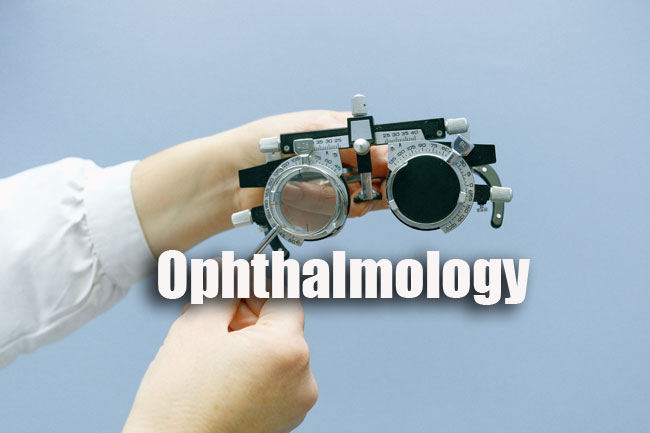Ophthalmology Quiz
Ophthalmology Quiz paper for the written examination is given below. Candidates who are looking for Ophthalmology exam Quiz paper can find in this section. The applied candidates who are getting prepared for the Ophthalmology can view this page for the Ophthalmology Last Ten Years Quiz Papers.

Download the Ophthalmology Quiz & Solutions & make it as a reference for your exam preparation. Take advantage of these Ophthalmology Quiz Papers in a proper manner to get qualifying Marks. Last 5 years Ophthalmology Quiz Papers provided here. Candidates who are applied for the above exam can check and download the Ophthalmology Quiz Papers from here.
Quiz on Ophthalmology
1. The volume of the orbit is about —
(1) 30 cc
(2) 50 cc
(3) 40 cc
(4) 60 cc
2. Incorrect about Xanthelasma is —
(1) Commonly bilateral condition.
(2) Typically affecting middle aged and elderly individual.
(3) Hyperlipidemia is found in about 1/3rd of patients.
(4) Fat in Xanthelasmata is mainly extracellular.
3. Anterior uveitis is characterised by all, except —
(1) Aqueous flare
(2) Shallow anterior chamber
(3) Circumcorneal congestion
(4) Miosis
4. Ocular lesions of Gout include all of the following, except —
(1) Episcleritis
(2) Scleritis
(3) Keratitis
(4) Uveitis
5. Optical coherence tomography is most useful in disorder of —
(1) Macula
(2) Crystalline lens
(3) Refractive errors
(4) Intraocular tumours
6. Angiography is the investigation of choice in —
(1) Posterior vitreous detachment
(2) Rhegmatogenous retinal detachment
(3) Retinoschisis
(4) Central serous retinopathy
7. Most common primary intraocular tumour in children is—
(1) Retinoblastoma
(2) Malignant melanoma of choroid
(3) Malignant melanoma of ciliary body
(4) Rhabdomyosarcoma
8. Bilateral granulomatous panuveitis is seen in —
(1) Heerfordt’s syndrome
(2) Reiter’s syndrome
(3) Behcet’s disease
(4) Toxoplasmosis
9. All of the following are anterior dystrophies, except –
(1) Reis — Bucklers’ dystrophy
(2) Meesmann’s dystrophy
(3) Schnyder’s dystrophy
(4) Stocker — Holt’s dystrophy
10. Cogan’s syndrome is associated with –
(1) Keratitis — Interstial type
(2) Conjunctivitis
(3) Iritis
(4) Myopia
11. Axenfeld anomaly is seen in glaucoma associated with –
(1) Aniridia
(2) Phakomatosis
(3) Ectopia lentis
(4) Indocorneal dysgenesis
12. All of the following are seen in Favre Goldmann syndrome, except –
(1) Ectopia lentis
(2) Retinoschisis
(3) Nyctalopia
(4) Pigmentary changes similar to retinitis pigmentosa
13. Which of the following is true regarding Mittendorf dot?
(1) Glial tissue project from optic disc
(2) Obliterated vessel run forward into the vitreous
(3) Associated with posterior polar cataract
(4) Commonest congenital anomaly of hyaloid system
14. In hypermetropic anisometropia, aniseikonia can be reduced by which one of these methods?
(1) Decreasing the distance between the spectacle lens and cornea.
(2) Increasing the front curvature of the spectacles lens without changing the lens power.
(3) Reducing the thickness of the spectacle lens without changing the lens power.
(4) Using high refractive index glass.
15. Which of these values represents the logMAR equivalent of a visual acuity of 6/6?
(1) 0.0
(2) 0.1
(3) 0.66
(4) 1.0
16. With regard to spherical aberration, which statement is correct?
(1) A concave lens causes light passing through the periphery of the lens to be refracted more than when passing through its centre.
(2) Itis least in a plano — convex lens when the plane surface faces the object.
(3) It is reduced in the eye by the decreasing radius of curvature towards the periphery of the cornea.
(4) It may be reduced by decreasing the aperture in front of the lens.
17. Which IOL power formula requires a measured Anterior Chamber Depth (ACD)?
(1) Haigis
(2) Hoffer Q
(3) Holliday 1
(4) SRK-T
18. Arden index is used for interpretation of —
(1) Visual evoked response
(2) Electrooculogram
(3) Electroretinogram
(4) Visual field charting
19. Diplopia in superior oblique palsy is —
(1) Vertical diplopia on downward gaze
(2) Vertical diplopia on upward gaze
(3) Horizontal diplopia on inward gaze
(4) Horizontal diplopia on outward gaze
20. Which of the following is false regarding intraocular retinoblastoma?
(1) 94% cases are sporadic.
(2) Individuals with sporadic retinoblastoma do not pass their genes to their children.
(3) Reese Ellsworth classification is used for predicting visual prognosis following radiotherapy.
(4) Tumour calcification can be detected by an ultrasound scan.
| Practice Set | MCQs |
| Quiz | Questions and Answers |
| Ophthalmic Surgery |
21. Terson Syndrome is —
(1) Multiple intraretinal haemorrhage with intra arterial bleeding from head trauma.
(2) Superficial retinal haemorrhage associated with Acute pancreatitis.
(3) Superficial retinal haemorrhage associated with Blood dyscrasia.
(4) Superficial retinal haemorrhage associated with Chronic renal failure.
22. False about Argyll Robertson Pupil is –
(1) Accommodation reflex normal
(2) Direct pupillary reflex absent
(3) Indirect pupillary reflex normal
(4) Visual acuity normal
23. Drainage of sub retinal fluid in surgery is usually —
(1) Most dependent point of break
(2) At the site of SRF collection
(3) Just above or below the horizontal meridian either temporally or nasally
(4) Any place around scleral buckle
24. Ahmed Glaucoma valve is a —
(1) Flow restricted drainage device
(2) Open tube drainage device
(3) Express shunt device
(4) None of the above
25. Metabolite like mitomycin concentration to be used during filtration surgery in children is —
(1) 0.1 to 0.2 mg/mL
(2) 0.2 to 0.4 mg/mL
(3) 0.4 to 0.6 mg/mL
(4) 0.6 to 0.8 mg/mL
26. Antiglaucoma drug contraindicated in infant —
(1) Brimonidine
(2) Latanoprost
(3) Bimatoprost
(4) Timolol
27. Inverse glaucoma is seen in —
(1) Complicated contract
(2) Spherophakia
(3) Pigmentary glaucoma
(4) Glaucoma capsular
28. A 26-year-old male patient has normal anterior chamber, cicumciliary congestion and patient complains of photophobia, redness, pain and watering from last 3 days on torch light the pupil is small. What is the likely diagnosis?
(1) Acute anterior iritis
(2) Acute angle closure glaucoma
(3) Open angle glaucoma
(4) Orbital cellulitis
29. Ophthalmoplegic migraine is best characterised as –
(1) Recurrent headache with transient palsy of ophthalmic nerve.
(2) Headache associated with irreversible palsy of 3rd nerve.
(3) Recurrent headache with transient palsy of 3, 4 and / or 6th cranial nerves.
(4) Headache with optic neuritis.
30. Most common cause of fungal orbital cellulitis in diabetes is —
(1) Aspergillus
(2) Fusarium
(3) Mucormycosis
(4) Candida
31. Congenital absence of eyelid with skin passing continuously from head to cheek over a malformed eye is —
(1) Ankyloblepharon
(2) Crypto — ophthalmos
(3) Pseudo — cryptoopthalmos
(4) Euryblepharon
32. Most important cause of neurogenic ptosis is —
(1) Multiple sclerosis
(2) Ocular myopathy
(3) 3rd cranial nerve palsy
(4) Myasthenia gravis
33. Which type of senile cataract is notorious for glaucoma formation?
(1) Incipient cataract
(2) Hypermature Morgagni
(3) Intumescent cataract
(4) Nuclear cataract
34. Use of Tamoxifen for breast cancer can cause all of the following adverse effects, except —
(1) Thromboembolism
(2) Endometrial carcinoma
(3) Carcinoma in contralateral breast
(4) Cataract
35. Marfan syndrome has all ocular sign, except —
(1) Megalocornea
(2) Lattice degeneration
(3) Bilateral subluxation of lens
(4) Axial hypermetropia
36. A 40-year person came to tertiary centre for disability certificate. His vision in right eye 6/36 and left eye 6/60 with best corrective glasses, his disability will be —
(1) 20%
(2) 30%
(3) 40%
(4) 50%
37. Eye Donation Fortnight is celebrated during which time of year for awareness about eye donation?
(1) July 25 to August 8
(2) August 25 to September 8
(3) September 25 to October 8
(4) October 25 to November 8
38. Khodadoust line is —
(1) Post traumatic inflammatory line
(2) Post uveitis inflammatory line
(3) Post corneal graft endothelial rejection
(4) Post cataract TASS line
39. The patient came for cataract surgery. His IOP was normal but on slit lamp examination he had pseudoexfoliation syndrome with Grade II cataract. There was a line of increased pigmentation anterior to schwalbe line. The most probable term is —
(1) Pigment dispersion syndrome
(2) Sampaolesi line
(3) Post blunt trauma line
(4) Hudson Stahli line
40. The approach to check accurate power of IOL, based on artificial intelligence —
(1) Barrett Universal II
(2) Olsen
(3) Haigis
(4) Hill —RBF method
41. A child 7-year-old have severe asthenopia. On examination his vision was 6/6 BE with no spectacles but had severe convergence insufficiency. What therapeutic prism should be given?
(1) Base – out prism
(2) Base—in prism
(3) Neutral prism
(4) None of the above
42. Test for contrast sensitivity —
(1) Kay Picture Test
(2) Roman Test Type
(3) Dot Visual Acuity Test
(4) Pelli-Robson Chart
43. The latest recombinant human growth factor approved for neurotrophic keratitis is —
(1) Interferon
(2) Bevicanzumb
(3) DIFLEPRICEPT
(4) Cenegermin-bkb Ophthalmic solution (0.002%)
44. Head up viewing with digitally assisted vitreretinal surgery a new emerging technology to create a 3D imaging view is called as —
(1) Phakosonics
(2) Imperial
(3) Negenuity
(4) Constellation
45. A young patient was being operated for phacoemulsification cataract surgery develops a large posterior capsule tear. What will you do from beginning to end step?
(1) Pull out immediately from AC ——- use low molecular weight viscoelastic AC maintainer — Vitrectomy + single piece PMMA lens in sulcus
(2) Do not pull out ——— use low molecular weight viscoelastic ——— single piece JOL in sulcus —– AC maintainer – Vitrectomy
(3) Do not pull out ——— use low molecular weight viscoelastic ——— AC maintainer – Vitrectomy + hydrophilic lens in sulcus
(4) Do not pull out ——— use high molecular weight viscoelastic ——— AC maintainer —— central core vitrectomy —— 3 piece JOL in sulcus
46. For the successful outcome of FLACS surgery, the most important step is —
(1) Locking process
(2) Docking process
(3) Jokeing Process
(4) Mocking process
47. Femtosecond laser is —
(1) Infrared laser with wavelength of 1053 nm with ultrashort pulse duration.
(2) UV laser with wavelength of 660 nm with long pulse duration.
(3) Infrared laser with wavelength of 1053 nm with supersonic pulse duration.
(4) Infrared laser with wavelength of 680 nm with release based pulse duration.
48. Cataract in galactosemia is caused by accumulation of —
(1) Sorbitol
(2) Galactitol
(3) Galactose
(4) None of the above
49. The most common second malignancy in survivors of retinoblastoma is —
(1) Thyroid cancer
(2) Nasopharyngeal carcinoma
(3) Optic glioma
(4) Osteosarcoma
50. Contact lens wear is proven to have deleterious effects on the corneal physiology. Which of the following statement is incorrect in connection with contact lens wear?
(1) The level of glucose availability in the corneal epithelium is reduced.
(2) There is a reduction in hemidesmosome density.
(3) There is increased production of CO2 in the epithelium.
(4) There is a reduction in glucose utilization by comeal epithelium.



